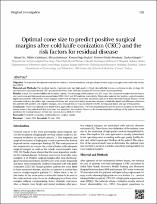| dc.contributor.author | Öz, Murat | |
| dc.contributor.author | Çetinkaya, Nilüfer | |
| dc.contributor.author | Korkmaz, Elmas | |
| dc.contributor.author | Seçkin, Kerem Doğa | |
| dc.contributor.author | Meydanlı, Mehmet Mutlu | |
| dc.contributor.author | Güngör, Tayfun | |
| dc.date.accessioned | 2019-05-13T09:03:27Z | |
| dc.date.available | 2019-05-13T09:03:27Z | |
| dc.date.issued | 2016 | |
| dc.identifier.citation | Öz, M., Çetinkaya, N., Korkmaz, E., Seçkin, K. D., Meydanlı, M. M., Güngör, T. (2016). Optimal cone size to predict positive surgical margins after cold knife conization (CKC) and the risk factors for residual disease. Journal of the Turkish German Gynecological Association, 17(3), 159-162. | en_US |
| dc.identifier.issn | 1309-0399 | |
| dc.identifier.uri | https://doi.org/10.5152/jtgga.2016.16066 | |
| dc.identifier.uri | https://hdl.handle.net/11491/1475 | |
| dc.description.abstract | Objective: To determine the optimal cone size to achieve a reliable sensitivity and specificity for clear surgical margins after cold knife conization (CKC). Material and Methods: The medical reports of patients who had high-grade cervical intraepithelial lesions, carcinoma in situ, or stage 1A1 microinvasive carcinoma in their CKC specimens between June 2008 and January 2015 were reviewed retrospectively. Results: In total, 315 women fulfilled the inclusion criteria. The mean age of the patients was 40.7 years. The conization results were microinvasive carcinoma and high-grade squamous lesion (HSIL) for 8 and 307 patients, respectively. Ninety-nine patients had positive surgical margins. Eighty-one patients with positive cone margins underwent the repeat excisional procedure and 35 of them showed residual disease. In the univariate analyses, the patient age, menopausal status, and mean cone height parameters showed statistically significant differences between the patients with positive and negative margins. Also, residual disease was associated with the menopausal status and age of the patients. Conclusion: There is no optimal cone depth that is applicable for all patients. The most important predictors for positive margins are the menopausal status of the patient and that more than two quadrants are involved. However, the menopausal status and age of the patients were still predictors for residual disease. © 2016 by the Turkish-German Gynecological Education and Research Foundation. | en_US |
| dc.language.iso | eng | |
| dc.publisher | Turkish-German Gynecological Education and Research Foundation | en_US |
| dc.relation.isversionof | 10.5152/jtgga.2016.16066 | en_US |
| dc.rights | info:eu-repo/semantics/openAccess | en_US |
| dc.subject | Cold Knife Conization | en_US |
| dc.subject | Residual Disease | en_US |
| dc.subject | Surgical Margin | en_US |
| dc.title | Optimal cone size to predict positive surgical margins after cold knife conization (CKC) and the risk factors for residual disease | en_US |
| dc.type | article | en_US |
| dc.relation.journal | Journal of the Turkish German Gynecology Association | en_US |
| dc.department | Hitit Üniversitesi, Tıp Fakültesi, Cerrahi Tıp Bilimleri Bölümü | en_US |
| dc.identifier.volume | 17 | en_US |
| dc.identifier.issue | 3 | en_US |
| dc.identifier.startpage | 159 | en_US |
| dc.identifier.endpage | 162 | en_US |
| dc.relation.publicationcategory | Makale - Uluslararası Hakemli Dergi - Kurum Öğretim Elemanı | en_US |


















